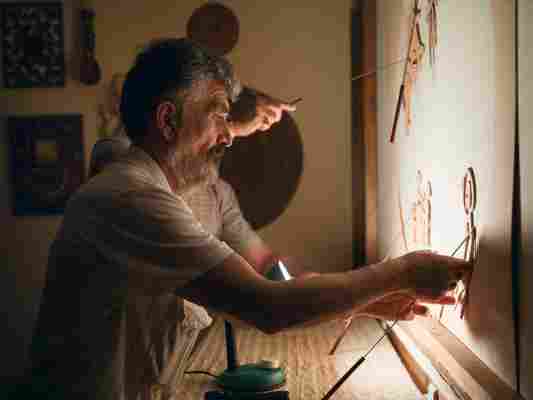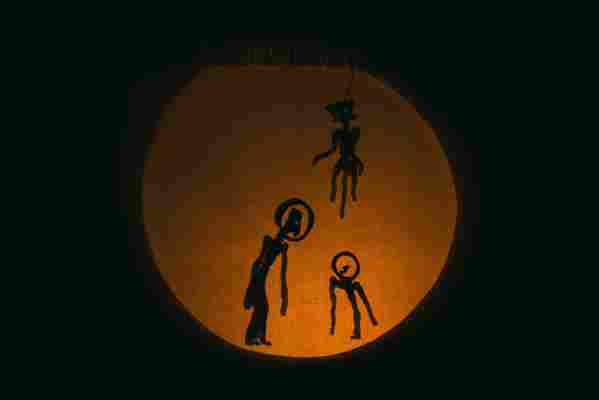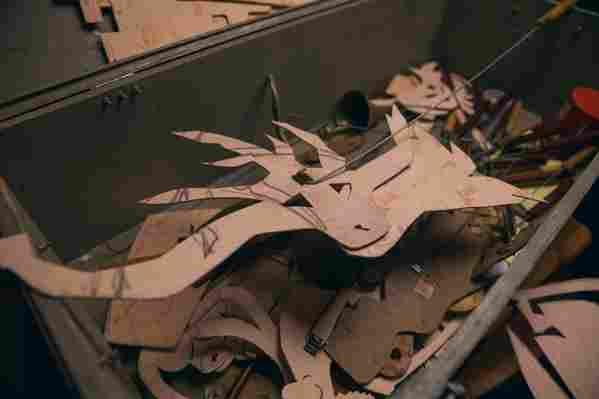
Behind a screen, puppets mounted on long, slim sticks dance and sway, twirling, backlit so that only their dark shadows appear, while puppeteers called Karagyoz players sing, provide sound effects and create voices for the characters. An interpreter translates, telling in English the Armenian stories like a libretto for an opera, so the audience will understand.
The Armenian Shadow Puppet Theater, known as Karagyoz, was especially popular in the 18th century. But it has roots dating back to the 14th century, with shared sources in South Asia, the Middle East and North Africa.
“They are oldest in Egypt and the countries of Maghrib , Greece and the Ottoman Empire,” explains Levon Abrahamian, an anthropologist and a curator of the 2018 Armenia program at the Smithsonian Folklife Festival . “Armenians were doing this in the Ottoman Empire because part of Armenia, Western Armenia, is now in Turkey.”
Now, a new version of the Armenian Shadow Puppet Theater, called Ayrogi, is touring Armenia, staging modern performances reviving the traditions of the past. Ayrogi performed at this year’s Folklife Festival, which concluded this past weekend. Some of the players travel by horseback , stopping to perform horse shows, songs, folk dances and shadow puppet shows.
“Our riding club is called Ayrudzi,” says the director Armen Kirakosyan. “ Ayr is ‘man’ and dzi is ‘horse.’ Man and horse,” Kirakosyan explains, sometimes speaking through a translator. “We call our shadow theater Man and Soul, ayr and vogi, Ayrogi.”
Though Ayrogi has deep roots in history and similarities to puppet theaters in Syria, Greece and Egypt, there are important differences in form and substance in Armenia, where stick puppets are made from animal skin of varying thickness—often donkey, horse or camel. The puppets in Turkey, Nepal and Indonesia were brightly colored, and hues were symbolic signifiers. In Armenia, the puppets are not.
“In Nepal, red is often the heroic person, green is something like jealousy and black is also positive and can be heroic,” Kirakosyan explains with curator Abrahamian translating. “In Armenian theater, the puppets were colored in black, so it is a principle of shadow. The light comes from behind them in such a way that you have only shadows.” Black and white, he says, has a far greater impact on the imagination, and the characters develop a much more menacing or hilarious presence in the minds of the viewers. “It gives, from the first glance, more sources for imagination for the story.”
In Armenia and Turkey, the character known as Karagyoz, meaning “black eyes,” is the principal trickster, but also the main hero. He is an uneducated commoner who is both brave and emotional. He wears a high hat, but also has a long hand that one scholar George Goyan , the author of several books on the history of Armenian theater , interprets as a phallus. Kirakosyan says the second main character, Haji Ayvaz, has a more modest reputation and has been on a hajj to Mecca. He is a decent, loyal and pious person who often advises his counterpart that what he is doing is forbidden by God. Several old fairytales and plays feature the two, including a play called “Story about Yogurt.”
“The story consists of some seven to eight scenes,” Kirakosyan explains. “Karagyoz wants to marry, and Haji Ayvaz is trying to help him. So he gives Karagyoz kind of an Armenian yogurt to sell and have some money for his wedding.” Some of the stories about the pair are strange and others are funny, he says. Sometimes the trickster is caught peeping at women in the bath—traditional scenarios from the 19th century. “Then Karagyoz is killed for peeping at the women and doing some other things that are forbidden. He finds himself in the underworld, and then he is resurrected. . . . Many traditional ancient puppet theaters deal with a hero—a trickster hero—who is killed and resurrected.”
Abrahamian explains that the shadow theater’s origins are ritual—it was not devised merely to entertain.

“The main idea is that the hero goes underworld and then he resurrects, and then he is a shadow. This shows also the ritual. Only men were allowed to show this theater and it was only for men,” Abrahamian says. “Sometimes the stories were really very rude,” he says, adding that today, the stories are less crude. “The old popular theaters, from the medieval times, were obscene actually. That is why the hero is phallic, doing obscene things from our point of view but perhaps it was some ritual things that they did at the time.”
The stories Ayrogi tells now are for a general audience, and many are adapted for children. Modern shadow puppetry, Abrahamian says, is based on traditional folktales such as “The Cat of Martiros.” Martiros is a popular Armenian name meaning “martyr,” and the theater company performs a series of tales about him.
One story begins with a man who is content and free of troubles, says Kirakosyan in Armenian as Abrahamian translates. He laughs because the man’s life is about to get complicated.
“The man is complaining about this mouse, saying it is eating his shoes. . . Kind people came and said, ‘We will help you,’ giving him a cat. The cat solved the problem but created other problems, meowing, and the man says he can’t sleep. So the people say, ‘it is hungry, thirsty—give him milk!’ But where would he get the milk? So they give him a cow to solve the problem. He had to have a field to have something for the cow to eat some grass. Lots of problems come, so they give him a wife! Now he has a lot of children, and when he is dying, he calls his eldest son, and tells him, ‘You can do anything you want, but never let a cat come to your house!’” The show is very popular, he adds.

Kirakosyan and others established the horse riding club when he was a student, and organized trips all over Armenia every summer. Then they added traditional dancing and singing, and asked anthropologist Jenya Khachatryan for advice. Kriakosyan says she was teaching them traditional dances and then they suddenly learned that she knew the tradition of the shadow puppet theater from field work she had conducted in the 1960s. She had worked with and learned from the puppet master Khachatur Tumasyan, whose grandfather had been a shadow puppet player after moving in the 1830s from Erzurum, Turkey, to southern Georgia.
Khachatur Tumasyan, Abrahamian says, was one of the last masters running a shadow puppet theater in Armenia in the 1960s. Tumasyan used his grandfather’s puppets, which are currently on display at the Museum of Ethnography of Armenia .
In 1982, Kirakosyan and his fellow students, after learning from Khachatryan the age-old traditions, revived the theater for their horse-riding trips, taking the shows to children in their villages. “We made some copies of the traditional scenarios and puppets, and we use some of the copies in our performances,” Kirakosyan explains.
Abrahamian says all of this is thanks to the work of Khachatryan, who recently passed away.
“I am an anthropologist myself, so [I know] an anthropologist can transpose the tradition even just because they are working in the field. And this was a very good story,” Abrahamian says, noting that it was through the hard work and dedication of a woman that the tradition was passed along even as women were prohibited from seeing the shows. “She wrote this down from the last puppeteer and now the new puppeteers are continuing it due to the good work of our anthropologist.”
Asked what Americans who aren’t familiar with Armenian culture will think about Ayrogi, Abrahamian tells one last story.
“There’s a poor man who goes to visit God and asks for some happiness. On the way, he met a hungry wolf who said, ‘I am hungry and have nothing to eat. Ask God . . . what should I do?’ Then he sees a woman, a young woman who is also alone,” Abrahamian continues. “She also says, ‘If you are going to God, ask him to help me.’ Then there’s a tree, which needs help because he doesn’t have any apples. He gets to God and God says, ‘Go, happiness is waiting in your house.’ He sees the tree again, who asks the man what happened. The man tells the tree, ‘Your treasure is under your roots. It is forbidden for apples to grow,’ and the tree offers the man the treasure because the tree would rather grow apples. ‘I have no time,’ says the man, ‘I am going to find my happiness.’ Then he meets the woman, who asks what happened. The man tells her God said she should marry a man. The woman, who is beautiful, asks the man to please marry her. The poor man says he has no time, because he has to go home! What God told the man about the wolf we don’t know because God said in the wolf’s ear: ‘When you find the stupid man, eat him, and you’ll solve your problem!’”
These are the kinds of stories, Abrahamian says laughing, that everybody can understand!
